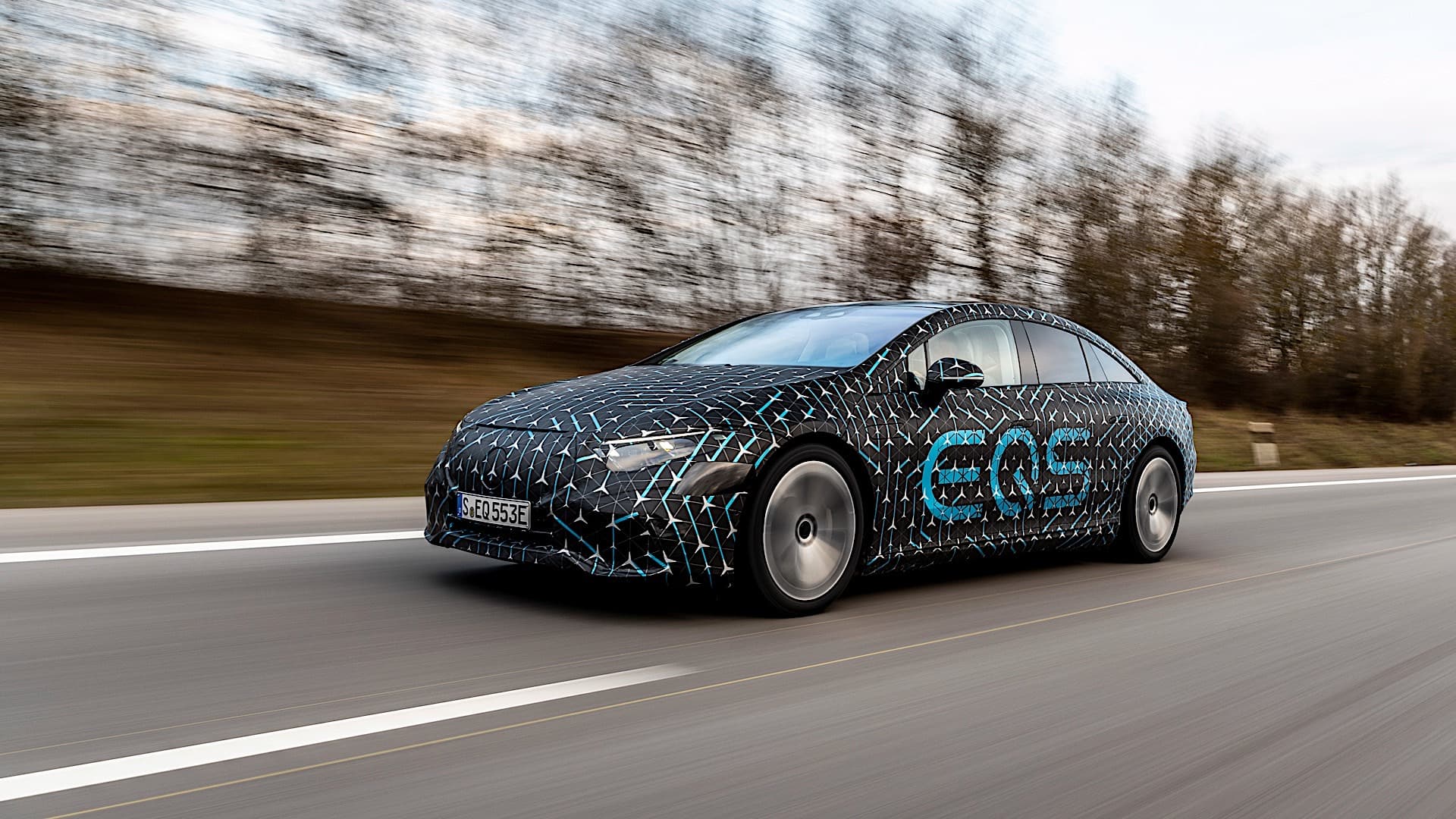Mercedes-Benz has released an outline of the EQS’ powertrain range, which will launch in two flavors: the EQS 450+ and EQS 580. Power ratings will range from 328 hp to 516 hp with the standard models while a more powerful performance-oriented version is scheduled to come at a later time. Torque figures are 419 lb-ft for the EQS 450+ and 630 lb-ft in the EQS 580. Single- or dual-motor configurations will be offered. The former will be RWD while the latter features AWD with a torque shift function that distributes torque continuously between both axles and ensures the most efficient use of the powertrain
Depending on which powertrain you choose, the EQS can travel up to 770 km or 478 miles per charge in the WLTP cycle. Expect the EPA ratings to be lower due to a more conservative testing cycle. Regenerative braking will be available in three levels via paddle shifters and can bring the EQS to a complete stop and will even anticipate vehicles ahead that are decelerating.
The EQS’ NVH has been optimized to make sure it’s as quiet as possible. A special foam covers the electric motors while the floor under the battery is beaded. Two acoustic dividers have also been added to the tailgate while the inverter has been sandwiched in three layers of metal and plastic. Even the magnets inside the motors have been arranged so that they don’t make much noise, which also led to fewer rare-earth metals being used.
Two liquid-cooled lithium-ion battery options will be available on the 2022 Mercedes-Benz EQS: a 90- or a 107.8-kWh unit featuring 10- and 12-cell modules depending on the drivetrain configuration. The batteries can accommodate 400V charging and its management system will be improved via over-the-air updates. Intelligent thermal management helps keep temperatures in check and allows the car to preheat or cool the battery while driving. Mercedes has also optimized the mix of nickel, manganese, and cobalt to an 8:1:1 ratio and has built the battery with recyclability in mind. It will also produce the battery in a sustainably powered facility in Hedelfingen, Germany in 2022.
To help make the EQS as efficient as possible, Mercedes pushed to make it as aerodynamic as possible. As a result, the EQS’ drag coefficient is an impressive 0.20. This was achieved via a sweeping coupe-like silhouette, a smooth underbody, an enclosed front end, a flat windshield, aerodynamically focused wheels up to 21 inches, front and rear wheel spoilers, and a functional rear spoiler optimized for lift and air drag. To cut wind noise, the EQS gets retracting door handles, additional door and window seals, a six-sided window, improved door structures, and special trim on the A-pillar. An optional Acoustic Comfort package adds laminated glass.
Mercedes has also made the EQS’ battery better protected during accidents by enclosing it in a double-walled plate made of energy-absorbing structures. The way the powertrain components were built also made sure they didn’t become a risk in accidents and even tested the battery’s behavior during impact load, overheating, overcharging, and when something penetrates it. The EQS’s high voltage systems switch off automatically in case of danger and have a standard crash monitoring system that activates when it’s parked.
A Navigation with Electric Intelligence feature suggests the fastest route and takes into consideration traffic, charging station location, ambient temperature, the type of chargers available, and energy demand. It’ll even adapt to the current flow of traffic and adjust the EQS’ energy demand and modify the route if needed. The feature also shows you if the battery capacity can get you back to your starting point without charging. Drivers can also edit the route if needed, allowing them to change the state of charge at the destination from the standard 10 percent, add charging stops, calculate charging costs, and exclude proposed charging stations.
Using DC charging, the EQS can charge at 200kW, allowing it to gain 300 km or 186 miles in the WLTP cycle in 15 minutes. There’s also an optional 22 kW charger for faster charging at home. Temperature and charge management helps maintain high charging currents. In Japan, the EQS will get bidirectional charging, allowing it to feed electricity back to the grid when needed.
Mercedes me Charge gives you access to over 500,000 AC and DC chargers worldwide with 200,000 in Europe alone. The Plug & Charge feature lets you simply plug the car in charge and will be compatible with the IONITY ecosystem in Europe. This will also send you to charge at stations that get sustainably sourced electricity via the MBUX interface or the Mercedes me app.
By 2030, Mercedes-Benz wants half of its vehicle sales to consist of electrified models, which include all-electric and plug-in hybrids. Sustainability is a key pillar in building new vehicles with 80 kg or 176 pounds of the EQS’ components consisting of recyclable or renewable materials. Factory 56 in Sindelfingen, Germany where the EQS will be built is a carbon-neutral facility. Mercedes-Benz is aiming to be carbon-neutral by 2039 and the arrival of the EQS is the start of that because it launches the brand’s push toward a sustainable fleet. By 2022, the EQ lineup will grow to eight vehicles.

